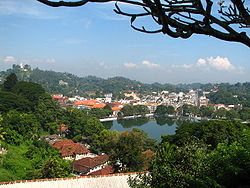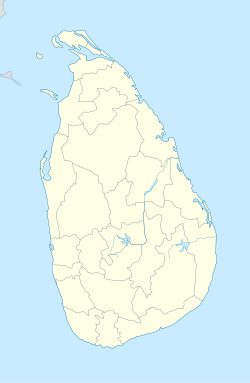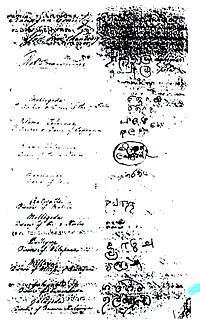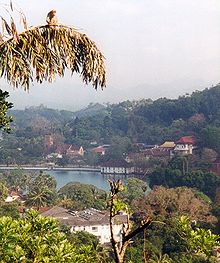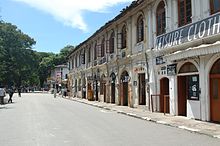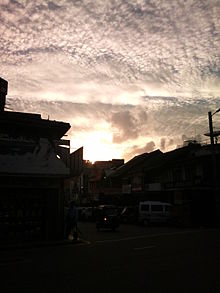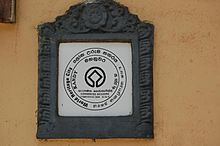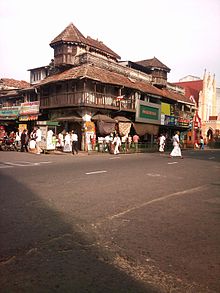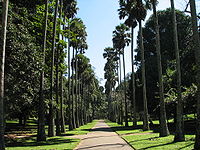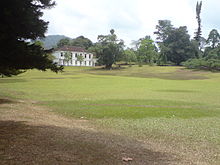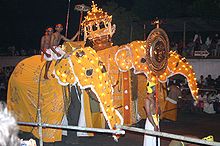- Kandy
-
Kandy
මහ නුවර
கண்டி— City — Kandy lake and the City centre
SealNickname(s): Nuwara, Kanda Uda Rata, Senkadagala, Senkadagala Pura Motto: Loyal and Free Coordinates: 7°17′49.06″N 80°38′18.43″E / 7.2969611°N 80.6384528°E / 7.2969611; 80.6384528Coordinates: 7°17′49.06″N 80°38′18.43″E / 7.2969611°N 80.6384528°E / 7.2969611; 80.6384528 Country Sri Lanka Province Central Province District Kandy District Divisional Secretariat Kandy Divisional Secretariat Senkadagalapura 14th century Kandy Municipal Council 1865 Founder Vikramabahu III Government - Type Municipal Council - Body Kandy Municipal Council - Mayor Raja Pushpakumara Area - Total 1,940 km2 (749 sq mi) - Land 1,917 km2 (740.2 sq mi) - Water 23 km2 (8.9 sq mi) Elevation 500 m (1,640 ft) Population (2001) - Total 110,049 - Density 56.7/km2 (146.9/sq mi) Demonym Kandyan Time zone Sri Lanka Time (UTC+05:30) Website kandycity.org Kandy (Sinhala: මහ නුවර Maha Nuvara, pronounced [mahaˈnuʋərə]; Tamil: கண்டி kaṇṭi, pronounced [ˈkaɳɖi]) is a city in the center of Sri Lanka. It was the last capital of the ancient kings' era of Sri Lanka.[1] The city lies in the midst of hills in the Kandy plateau, which crosses an area of tropical plantations, mainly tea. Kandy is one of the most scenic cities in Sri Lanka; it is both an administrative and religious city. It is the capital of the Central Province (which encompasses the districts of Kandy, Matale and Nuwara Eliya) and also of Kandy District. Kandy is the home of The Temple of the Tooth Relic (Sri Dalada Maligawa), one of the most venerable places for the Buddhist community of Sri Lanka and all around the world. It was declared a world heritage site by UNESCO in 1988.[2]
Contents
History
Toponymy
The city and the region has been known by many different names and versions of those names. Some scholars suggest that the original name of Kandy was Katubulu Nuwara located near present Watapuluwa. However the more popular historical name is Senkadagala or Senkadagalapura. According to folklore this name originated from one of the several possible sources. One being the city was named after a brahmin with the name Senkanda who lived in a cave near by, and another being a queen of Vikramabahu III was named Senkanda, and after a coloured stone named Senkadagala. The Kingdom of Kandy has also been known by varius names. The present name Kandy is derived from an anglicized version of the Sinhalese Kanda Uda Rata (meaning the land on the mountain) originated during the colonial era. The Portuguese shortened this to "Candea", using the name for both the kingdom and its capital Senkadagalapura. In Sinhalese, Kandy is called Maha Nuvara, meaning "Great City" or "Capital", although this is most often shortened to Nuvara, pronounced Nuwara.[3]
Founding
Historical records suggest that Kandy was first established by the Vikramabahu III (1357–1374 CE), who was the monarch of the Kingdom of Gampola, near the Watapuluwa area, north of the present city, and named Senkadagalapura at the time.
Early years and as a capital
History of Kandy 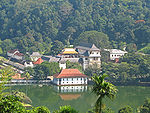
This article is part of a seriesKingdom of Kandy (1469–1815) Founding Sinhalese–Portuguese War Kandyan Treaty of 1638 Portuguese period in Ceylon Treaty of Batticaloa Kandyan Wars Colonial Kandy (1815–1948) Kandyan Convention Matale Rebellion South East Asia Command Kandy (1948–Present) Modern Kandy See also: An Historical Relation of the Island Ceylon List of Kandyan Monarchs History of Sri Lanka
Kandy Portal
v · Sena Sammatha Wickramabahu (1473–1511) was the first king of the Kingdom of Kandy, he was a royal from the Kotte Royal Blood line and ruled Kandy as a semi-independent kingdom under the Kingdom of Kotte, making it the new capital of the Kandyan Kingdom. Sena Sammatha Wickramabahu was followed by his son Jayaweera Astana (1511–1551) and then by Karaliyadde Bandara (1551–1581) who was succeeded by he daughter Dona Catherina of Kandy (1581-1581). Dona Catherina was succeeded by Rajasinha I. Rajasinha I however, preferred to rule the hill country from the Kingdom of Sitawaka on the west of the island. A period of turmoil for power ended with the ascent to the throne by Konappu Bandara who came to be known as Vimaladharmasuriya I. Vimaladharmasuriya I having embraced Buddhism consolidated his authority further by bringing the tooth relic of the Lord Buddha to Kandy from a place called Delgamuwa.[4]In 1592 Kandy became the capital city of the last remaining independent kingdom in the island after the coastal regions had been conquered by the Portuguese. Several invasions by the Portuguese and the Dutch (16th, 17th and 18th century) and later by the British (most notably in 1803) were repelled.
The kingdom tolerated a Dutch presence on the coast of Sri Lanka, although attacks were occasionally launched. The most ambitious offensive was undertaken in 1761, when King Kirti Sri Rajasinha attacked and overran most of the coast, leaving only the heavily fortified Negombo intact. When a Dutch retaliatory force returned to the island in 1763, Kirti Sri Rajasinha abandoned the coastline and withdrew into the interior. When the Dutch continued to the jungles the next year, they were constantly harassed by disease, heat, lack of provisions, and Kandyan sharpshooters, who hid in the jungle and inflicted heavy losses on the Dutch.
The Dutch launched a better adapted force in January of 1765, replacing their troops' bayonets with machetes and using more practical uniforms and tactics suited to jungle warfare. The Dutch were initially successful in capturing the capital, which was deserted, and the Kandyans withdrew to the jungles once more, refusing to engage in open battle. However, the Dutch were again worn down by constant attrition. A peace treaty was signed in 1766. The Dutch remained in control of the coastal areas until 1796, when Great Britain took them over (while the Netherlands under French control) as part of the Napoleonic wars. British possession of these areas was formalized with the treaty of Amiens in 1802. The next year the British also invaded Kandy in what became known as the First Kandyan War, but were repulsed.
As the capital, Kandy had become home to the relic of the tooth of the Buddha which symbolizes a 4th-century tradition that used to be linked to the Sinhalese monarchy, since the protector of the relic was the ruler of the land. Thus the Royal Palace and the Temple of the Tooth were placed in close proximity to each other.
The last ruling dynasty of Kandy were the Nayaks. Kandy stayed independent until the early 19th century. In the Second Kandyan War, the British launched an invasion that met no resistance and reached the city on February 10, 1815. On March 2, 1815, a treaty known as the Kandyan Convention was signed between the British and the Radalas (Kandyan aristocrats). With this treaty, Kandy recognized the King of England as its King and became a British protectorate. The last king of the kingdom Sri Vikrama Rajasinha was captured and taken as a royal prisoner by the British to Vellore Fort in southern India along with all claimants to the throne.
Colonial
During the British period in Sri Lanka the history of Kandy and it's townscape witnessed rapid and drastic change and particularly after the Uva Rebellion. Sir Lowry is noted for recording in his Gazetteer "The story of English rule in the Kandyan country during the rebellion of 1818 cannot be related without shame...Hardly a member of the leading families remained alive...Those whom the sword and the gun had spared, cholera and small pox and privations had slain by the hundreds...Others became ignorant and apathetic. Any subsequent development efforts of the government for many years were only attempts begun and abandoned".[5]
The first time Sri Lanka fully fell into the hands of a foreign power was in Kandy with the signing of the Kandyan Convention in 1815 at the Sri Dalada Maligawa. The king, Vikrama Rajasinha of Kandy who was of South Indian ancestry faced powerful opposition from the Sinhalese chieftains and sought to reduce his power. A successful coup was organized by the Sinhalese chieftains in which they accepted the British crown as their new king. This ended over 2500 years of Sri Lankan monarchs and the line of Kandyan monarchs and Rajasinha was taken as prisoner. By 2 March 1815 the islands sovereignty was under that of the British Empire. The treaty was not signed by the deposed King but by members of his court and other dignitaries of the Kandyan Kingdom.
In 1848 led by Gongalegoda Banda and Puran Appu saw the rebellion known as the Matale Rebellion. Prior to that the city and the country had been under British rule for 32 years, in which the British had expropriated the common land of the peasantry and reduced them to extreme poverty. The Kandyan villagers were forced to abandon their traditional way of life and become wage-workers in the abominable conditions that prevailed on these new estates and plantations that had been introduced, despite all the pressure exerted by the colonials the kandyans refused. This forced the British to bring in hundreds of thousands of Tamil coolies from southern India. The Rebellion began on the 26 July 1848 with Gongalegoda Banda, crowned as king, and Puran Appu, as prime minister, and their main objective to capture Kandy back from the British. The Matale Rebellion was a peasant revolt in the hands of the Common people, the Kandyan leadership being totally wiped out after the Uva Rebellion, marked the first step in a transition from the classic feudal form of anti-colonial revolt to modern independence struggles. The leadership was for the first time passed from the Kandyan provinces into the hands of ordinary people or non-aristocrats.
In 1944, during World War II, the South East Asia Command of the allies was moved to Kandy, where it remained till the end of the war.
Modern and contemporary
It is the second-largest city of the island and the capital of Central Province of modern Sri Lanka. Its geographic location has made it a major transportation hub in the island: while Kandy being the gateway to the Central Highlands[6] of Sri Lanka, the city can be reached by major motorways in every direction of the island. The railway line from Colombo, the sea port on the western coast runs via Kandy to the farthest point of Badulla[7] in the Central Highlands. The main roads Colombo-Kandy and Kandy-Nuwara Eliya[8] are two of the most scenic roads of Sri Lanka; Colombo-Kandy[9] road passes through rubber plantations and rice paddies, Kandy-Nuwara Eliya road cuts through paddy fields and seamless tea plantations. Both roads claw their way up winding, rounding over the rings of hills. Currently feasibility studies are afoot for another highway between Colombo and Kandy via Kadawata and the scenic city of Katugastota.
Government
Main article: Kandy Municipal CouncilThe Kandy Municipal Council governs the City of Kandy, it was established under the Municipalities Ordinance of 1865. The inaugural meeting had been held on 20 March 1866. The Kandy Town Hall was established in the present premises known as the Dunuwille Walawwe in 1870.[10]
The Government Agent of the Central Province had presided over the council until 1939 when the Mayor was elected. The first elected mayor was Sir Cuda Ratwatte. With further amendments to the ordinance in 1978 the Mayor became the Executive Head whilst the Commissioner was the Administrative head.
Presently the Council consists of 24 members. The Governing Party, United National Party has 14 and the opposition 10. The Council meets once a month to review the progress and decide on the implementation of its projects. Five standing committees of the Council, namely Finance, Law, Works, Sports and Welfare Services (Pre-Schools, Library), also meet monthly to evaluate and recommend to Council relative matters for approval.
Geography
Scope
The city of Kandy lies at an elevation of 465 metres (1,526 ft) above sea level. Its plan developed around two open spaces: an elongated square, at the end of which are the administration buildings of the old capital, and an artificial lake that is quadrangular in form. A public garden adds to the openness of the city's spatial organization.
On the north shore of the lake, which is enclosed by a parapet of white stone dating to the beginning of the 19th century, are the city's official religious monuments, including the Royal Palace and the Temple of the Tooth, known as the Dalada Maligawa (daḷadā māligāva). Reconstructed in the 18th century, the Dalanda Maligawa is built on a base of granite that was inspired by the temples of Sri Lanka's former capital city, Anuradhapura. An array of materials (limestone, marble, sculpted wood, ivory, etc.) contribute to the richness of this temple. Throughout this small holy city, a number of recent Buddhist monasteries can be found.
Kandy has now grown out to encompass Peradeniya, home to the University of Peradeniya and the Botanical Gardens, Katugastota to the north, and east to Kundasale, Tennekumbura and Gurudeniya.
Topography
Kandy is located in the mountainous and thickly forested interior of the island. The city is located in between multiple mountain ranges including the Knuckles mountain range and the Hanthana Mountain Range, giving the city an elevation of 500 metres (1,600 ft) above sea level. It lies adjacent to the artificial Kandy Lake and south of Udawatta Kele Sanctuary.
Climate
With Kandy located in the centre of the island and in a high elevation, the city has a relatively wetter and cooler temperatures than that of the tropical climate of the rest of the country, especially the coastal regions. The city has its dry season from December through to April.[11] From May through to July and December to January the region experiences its monsoon season, during this time the weather is rough and unstable. The island being in the northern hemisphere gives Kandy it coldest month in January and its hottest in July. From March through the middle of May is the intermonsonsoonal period, during this time there is light rain and strong humidity.[12] The humidity is generally between 70% to 79%.[13]
Climate data for Kandy Month Jan Feb Mar Apr May Jun Jul Aug Sep Oct Nov Dec Year Average high °C (°F) 30
(86)31
(88)31
(88)31
(88)31
(88)29
(84)29
(84)29
(84)29
(84)29
(84)29
(84)29
(84)29.75 Daily mean °C (°F) 23.6
(74.5)24.4
(75.9)25.7
(78.3)26.1
(79.0)25.8
(78.4)24.8
(76.6)24.4
(75.9)24.4
(75.9)24.5
(76.1)24.4
(75.9)24.2
(75.6)23.7
(74.7)24.7 Average low °C (°F) 22
(72)22
(72)23
(73)24
(75)26
(79)25
(77)25
(77)25
(77)25
(77)24
(75)23
(73)22
(72)23.83 Precipitation mm (inches) 86
(3.39)82
(3.23)89
(3.5)213
(8.39)164
(6.46)118
(4.65)119
(4.69)116
(4.57)155
(6.1)297
(11.69)303
(11.93)211
(8.31)1,953
(76.89)Rainfall mm (inches) 121.5
(4.783)66.5
(2.618)103.3
(4.067)179.0
(7.047)155.3
(6.114)204.5
(8.051)171.3
(6.744)140.8
(5.543)145.5
(5.728)286.5
(11.28)273.4
(10.764)217.3
(8.555)2,066.4
(81.354)Avg. rainy days 7 6 8 14 19 18 12 11 13 19 16 10 12.75 Sunshine hours 8 9 8 7 6 5 6 6 6 7 6 8 6.83 Source no. 1: [14][15] Source no. 2: [16] Divisions
Architecture
Main articles: Architecture of Kandy and Architecture of Sri LankaSacred City of Kandy * UNESCO World Heritage Site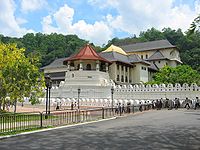
Country Sri Lanka Type Cultural Criteria iv, vi Reference 450 Region ** Asia-Pacific Inscription history Inscription 1988 (10th Session) * Name as inscribed on World Heritage List
** Region as classified by UNESCO- Palace of the Tooth relic
The monumental ensemble of Kandy is an example of construction that associates the Royal Palace and the The Temple of the Tooth (Palace of the tooth relic) is the place that houses the Relic of the tooth of the Buddha. Originally part of the Royal Palace complex of the Kandyan Kingdom, it is one of the holiest places of worship and pilgrimage for Buddhist around the world. It was last of a series of temples built in the places where the relic, the actual palladium of the Sinhalese monarchy, was brought following the various relocations of the capital city.
The Palace of the Tooth relic, the palace complex and the holy city of Kandy are associated with the history of the dissemination of Buddhism. The temple is the product of the last peregrination of the relic of the tooth of Buddha and the testimony of a religion which continues to be practiced today.
- Royal Palace
The Royal Palace of Kandy is the last Royal Palace built in the island. Although only part of the original palace complex remain. The Temple of the Tooth was part of this complex, due to the ancient tradition that stated that the monarch is the protector of the relic though which the ruler of the land. It today houses the National Museum Kandy which holds an extensive collection of artifacts from both the Kandy Kingdom and the British colonial rule.
- Lankatilaka Temple
The Lankatilaka Temple is considered to be one of the best preserved examples of traditional Sinhalese temple architecture. Built on a rock, the temple is reached by a long series of rock cut steps. An arched passage of the image house leads through a Mandapa (hall) into the inner sanctum which is richly decorated with beautiful floral designs. The two side walls and the ceiling are decorated with paintings. In the inner sanctum is a colossal seated image of the Buddha.
- Gadaladeniya Temple
The Gadaladeniya Temple's design is of South Indian origin with a Devale attached to it, similar in character to the Natha Devale and the Gedige of Adahana Maluwa. The main shrine room has a seated Buddha statue and the remains of some paintings of the Gampola period.
Among other important temples around Kandy[17] are Dodanwela Devale (shrine), Embakke Devale (shrine), Galmaduwa Vihara temple, Handagala Vihara temple, Lankatilaka Vihara, Medawala Vihara and Nalanda Gedige.
Parks and gardens
The Royal Botanical Garden, Peradeniya is situated about 5 km to the west of the city centre at Peradeniya and is visited by 1.2 million people per year. It is the largest botanical garden on the island.
The Udawatta Kele (Udawatta Forest) is a protected sanctuary situated in the heart of the city, just north of Temple of the Tooth. Known as "Uda Wasala Watta" in Sinhalese meaning, "the garden situated above the royal palace" it was designated as a forest reserve in 1856, and it became a sanctuary in 1938.
The Royal Palace Park, known as Wace Park is a small park that overlooks Kandy Lake and most of the city. In the park is a Japanese field gun which was captured by the British 14th Army in Burma during World War II and presented to the city of Kandy by Lord Mountbatten, Supreme Allied Commander South East Asia Theatre.
Demographics
Kandy is a Sinhala majority city; there are sizable communities belonging to other ethnic groups, such as Moors and Tamils.
Ethnicity in Kandy(2007) Population Percent Sinhalese 70.48% Sri Lankan Moors 13.93% Sri Lankan Tamils 8.57% Indian Tamils 4.77% Others 2.26% Ethnicity Population % Of Total Sinhala 77,560 70.48 Sri Lankan Moors 15,326 13.93 Sri Lankan Tamils 9,427 8.57 Indian Tamils 5,245 4.77 Other (including Burgher, Malay) 2,489 2.26 Total 110,049 100 Source:statistics.gov.lk
Religion
See also: Religion is Sri LankaKandy remains an important religious centre of the Sinhalese and a place of pilgrimage for Buddhists, namely those belonging to the Theravada school.
Economy
Kandy is second only to Colombo as the center of the Sri Lankan economy. It is the second-largest city of the island and the capital of Central Province of Sri Lanka. Many major corporations have large branch offices in Kandy and many industries include textiles, furniture, information technology and jewellery are found there. Many agriculture research centers are located throughout the city.
Tourism
Transport
Kandy has a public transport system based primarily on buses. The bus service is operated both by private companies and the government's own Sri Lanka Transport Board (SLTB).
Roads
- A-Grade highways
- A1 highway (Kandy road) connects Colombo with Kandy.
- A9 highway connects Jaffna with Kandy.
- A26 highway connects Padiyathalawa with Kandy via Mahiyangana.
- A10 highway connects Kurunegala with Kandy via Katugastota.
- High-speed expressways
- Colombo – Kandy high-speed elevated expressway running 115 km is currently under construction, providing a high-speed link between the two largest economic centers.
Rail
- Matale Line of the Sri Lanka Railways connects Kandy by way of Pradeniya and Matale. It connects to the Main Line that links Colombo and Badulla
Education
Tertiary education
The county's second oldest university, University of Peradeniya is at Peradeniya,and The Open University of Sri Lanka Kandy Premises also a suburb of Kandy. The Sri Lanka Institute of Information Technology has a center in the city, which is rather insignificant. Most of the private sector higher educational institutions also have their branches in Kandy.
The Geology Department at the University of Peradeniya in Kandy is the only Earth Science Department in Sri Lanka, having grown out of the Faculty of Science, with a long and distinguished history.
Kandy is also home to the Institute of Fundamental Studies (IFS). IFS is the premier institute of basic and applied research in Sri Lanka. IFS also trains around 32 graduate students at any given time.
Primary and secondary education
Kandy is home to some of the island's oldest boy schools and several girl schools as well.
Culture
Leisure and entertainment
Kandyans do many things for leisure and entertainment in in the city. Kandy is very popular due to the annual procession known as the Esala Perahera, in which one of the inner caskets used for covering the tooth relic of Buddha is taken in a grand procession through the streets of the city. This casket is taken on a royal tusker. The procession includes traditional dancers and drummers, flag bearers of the provinces of the old Kandyan kingdom, the Nilames (lay custodians of temples ) wearing their traditional dresses, torch bearers and also the grandly attired elephant. This ceremony which is annually held in the months of July or August, attracts large crowds from all parts of the country and also many foreign tourists.
Kandy City Centre is a new commercial and shopping complex [18] at Dalada Veediya.[19] Is the most modern commercial complex in Sri Lanka. The complex is studded with ultra modern features, also incorporating traditional architecture of Kandy during the medieval period of Sri Lanka. The city centre is host to several leading banks, a fully equipped supermarket, modern restaurants, an entertainment zone, a well designed state of the art food court, Sri Lanka's leading book shops, flora and an ayurweda site. There is a five-level car park outside that is the largest car park in Kandy.
Literature, film and television
Museums and art galleries
Culinary
Kandy has a modest range of restaurants, as well as an abundance of confectioneries. A range of cuisines is available, including Sri Lankan, Indian, Chinese, European and some multinational fast food outlets such as Pizza Hut, KFC and the Sri Lankan Fast Food chain Dinemore.[20]
Music
Sport
Main articles: Sport in Central Province, Sri Lanka and Sport in Sri LankaKandy has established a proud record of producing some of the top most sports people in Sri Lanka for a wide range of sports such as rugby union, cricket, football, swimming, hockey, athletics, table tennis, boxing, swimming, basketball, golf and even baseball, which has only been introduced into Kandy recently. Kandy has produced national captains of cricket and rugby, and athletes that play at the highest level of all sports.
Unlike the rest of the country rugby union is the most popular sport in the region. This is because of the local rugby union club, Kandy Sports Club being the reigning Club Rugby Champions in the national league for almost a decade, as well as the fondness and support the local schools treat the sport with. The Singer Sri Lankan Airlines Rugby 7's tournament is an annual international rugby union event held at the local Bogambara Stadium, attracting nations from all over the world.
Cricket is widely played in Kandy with the city having three first class teams in the Premier Trophy, Saracens, Kandy CC and Kandy Youth Cricket Club, as well as being the main city for the Sri Lankan Premier League side Kandurata Kites. Kandy is host to the Sri Lanka national cricket team with two Test status grounds, Asgiriya International Stadium and the newly built state of the art Pallekele International Cricket Stadium. Both stadiums have held World Cup matches.
Sports like Hockey, volleyball, the national sport of Sri Lanka, and Association football however has not taken off in Kandy as much as other sports, due to the lack of proper playing fields, funding and support and Cue games like billiards and snooker have hardly anyone playing. However Basketball, Table tennis, badminton and even swimming are popular due to the high participation of students and schools.[21]
See also
References
- ^ "Major Cultural Assests/Archaeological Sites". Department of Archaeology Sri Lanka. http://www.archaeology.gov.lk/arch_assets1.html. Retrieved 2010-10-24.
- ^ "Heritage Sites". Central Cultural Fund.
- ^ "Kandy Map". SriLankanMap. http://srilankanmap.com/kandymap.html. Retrieved 23 June 2011.
- ^ "Kandy Map". SriLankanMap. http://srilankanmap.com/kandymap.html. Retrieved 23 June 2011.
- ^ "Kandy Map". SriLankanMap. http://srilankanmap.com/kandymap.html. Retrieved 23 June 2011.
- ^ "Central highlands (Hill country) of Sri Lanka". http://www.mysrilankaholidays.com/central-highlands.html. Retrieved 2010-10-24.
- ^ "Badulla, Central Highlands of Sri Lanka". http://www.mysrilankaholidays.com/badulla.html. Retrieved 2010-10-24.
- ^ "Kandy - Nuwara Eliya Road". http://www.mysrilankaholidays.com/kandy-nuwara-eliya.html. Retrieved 2010-10-24.
- ^ "Colombo - Kandy Road". http://www.mysrilankaholidays.com/colombo-kandy.html. Retrieved 2010-10-24.
- ^ "The History of the Municipal Council". 2009-06-19. http://www.kandycity.org/kmc/index.html. Retrieved 2010-10-24.
- ^ "Kandy Weather". eZeeStay. http://www.hotels-in-kandy.com/kandy-hotels/kandy-weather.php. Retrieved 22 June 2011.
- ^ "Kandy Weather and When to Go". TripAdvisor. http://www.tripadvisor.com/Travel-g304138-s208/Kandy:Sri-Lanka:Weather.And.When.To.Go.html. Retrieved 22 June 2011.
- ^ "Kandy". tsitours. http://www.tsitours.com/srilanka/kandy.html. Retrieved 22 June 2011.
- ^ http://www.holidaycheck.com/climate-wetter_Kandy-ebene_oid-id_5766.html
- ^ http://www.audleytravel.com/Destinations/Indian-Subcontinent/Sri-Lanka/Places-to-Go/Kandy/Climate.aspx
- ^ http://www.worldclimate.com/cgi-bin/grid.pl?gr=N07E080
- ^ "Temple Excursions Around Kandy, Sri Lanka". http://www.mysrilankaholidays.com/around-kandy.html. Retrieved 2010-10-24.
- ^ http://www.pfik.org
- ^ "Sri Dalada Maligawa". http://www.sridaladamaligawa.lk/. Retrieved 2010-10-24.
- ^ "Dinemore :: Branches". Dinemore.lk. http://www.dinemore.lk/branches.htm. Retrieved 2011-03-13.
- ^ Marikar, Hafiz. "A Look At Sports In Kandy". The Sunday Leader. http://www.thesundayleader.lk/2010/12/26/a-look-at-sports-in-kandy/. Retrieved 22 June 2011.
Further reading
- Seneviratna, Anuradha (2008). The Kandy Asala Perahara. Sri Lanka: Vijitha Yapa Publications. ISBN 9556650174. http://www.vijithayapa.com/pdesc.php?id=24613.
- Seneviratna, Anuradha (1999). World Heritage City of Kandy, Sri Lanka: Conservation and Development Plan. Sri Lanka: Central Cultural Fund. ISBN 9556131264.
- Seneviratna, Anuradha (2008). Gateway to Kandy - Ancient monuments in the central hills of Sri Lanka. Sri Lanka: Vijitha Yapa Publications. ISBN 9556650259. http://www.srilankanbooks.com/pdesc.php?id=24684.
- Seneviratna, Channa (2004). Kandy at War: Indigenous Military Resistance to European Expansion in Sri Lanka 1594-1818. Manohar. ISBN 817304547X.
External links
- Kandy - The Hill Capital
- Bahirawa Kanda Kandy : The Legend of a Dreaded Demon
- Kandy city website
- Official UNESCO website entry
- MSN Map
- Kandy News Paper
v · d · eKandy History Kingdom of Kandy (List of Kandyan monarchs) · Battle of Gannoruwa · Kandyan Treaty of 1638 · Keppetipola Disawe · Kandyan Wars · Uva Rebellion · Matale Rebellion · Kandyan Convention · Radala
Government Geography Buildings and
landmarksHistoricalTemple of the Tooth · Royal Palace of Kandy · Natha Devale, Kandy · National Museum of Kandy · President's Pavilion · Queen's Hotel, KandyParks and GardensCulture Sports Kandurata cricket team · Asgiriya Stadium · Bogambara Stadium · Singer Sri Lankan Airlines Rugby 7's · Kandy Sports ClubEducation v · d · eLandmarks in Kandy Note: this includes landmarks in Kandy and its fringe areasCity Precincts Kandy CBD · University of Peradeniya
Shopping Kandy City Centre · Kandy Municipal Market
Entertainment Public Galleries D.S. Senanayake Memorial Public Library · Kandyan Art Association & Cultural Centre · National Museum of Kandy · Relic of the tooth of the Buddha · The Tea Museum
Institutions Asgiriya Maha Vihara · Buddhist Publication Society · District Secretariat, Kandy · Institute of Fundamental Studies · General Post Office · Kandy Municipal Council · Mayor of Kandy · List of schools in Kandy · Teaching Hospital Kandy
Structures Bahirawakanda temple · Bogambara Prison · Degaldoruwa Raja Maha Vihara · Kandy Clock Tower · Kandy Post Office · Kandy Town Hall · The Kandy House · Lankatilaka Temple · Natha Devale, Kandy · President's Pavilion · Queen's Hotel, Kandy · Royal Palace of Kandy · Sri Dalada Maligawa
Sports Stadia Asgiriya Stadium · Bogambara Stadium · Muttiah Muralitharan International Cricket Stadium · Victoria Golf & Country Resort
Parks/Spaces Athur's seat · British Garrison Cemetery · Central Highlands of Sri Lanka · Kandy Lake · Hanthana Mountain Range · Knuckles mountain range · Royal Botanical Gardens, Sri Lanka · Udawatta Kele Sanctuary · Wace Park
Transport Kandy Bus Station · Kandy Railway Station
See also: Events in Kandyv · d · eCities in Sri Lanka Capitals 
Other cities Anuradhapura · Badulla · Batticaloa · Dehiwala-Mount Lavinia · Galle · Hambantota · Jaffna · Kandy · Kurunegala · Maharagama · Matara · Moratuwa · Negombo · Nuwara Eliya · Polonnaruwa · Ratnapura · Trincomaleev · d · eUrban councils of Sri Lanka Ambalangoda · Ampara · Anuradhapura · Balangoda · Bandarawela · Beruwala · Boralesgamuwa · Chavakacheri · Chilaw · Dehiwala-Mount Lavinia · Embilipitiya · Eravur · Gampola · Hambantota · Haputale · Hatton-Dickoya · Hikkaduwa · Horana · Ja-Ela · Kadugannawa · Kalutara · Kattankudi · Katunayaka-Seeduwa · Kegalle · Kesbewa · Kinniya · Kolonnawa · Kuliyapitiya · Maharagama · Mannar · Minuwangoda · Monaragala · Mullaitivu · Nawalapitiya · Panadura · Peliyagoda · Point Pedro · Polonnaruwa · Puttalam · Seethawakapura · Tangalle · Talawakele-Lindula · Trincomalee · Valvettithura · Vavuniya · Wattala-Mabola · Wattegama · Weligamav · d · eProvincial capitals of Sri Lanka Colombo · Kandy · Galle · Jaffna · Trincomalee · Kurunegala · Anuradhapura · Badulla · Ratnapura

v · d · eWorld Heritage Sites in Sri Lanka Anuradhapura · Central Highlands · Galle and its Fortifications · Golden Temple of Dambulla · Kandy · Polonnaruwa · Sigiriya · Sinharaja Forest Reserve
v · d · eTopics on Central Province, Sri Lanka History Timeline of Central Province, Sri Lanka history:
Topics: History of Kandy · History of Matale · History of Nuwara Eliya · Pre-kingdom Kandy · Kingdom of Kandy · Kandyan Treaty of 1638 · Portuguese period in Ceylon · Kandyan Wars · Colonial Kandy · Kandyan Convention · Kandyan Convention · Matale Rebellion · South East Asia CommandGovernment Central Provincial Council · Provincial Governor · Chief Minister · General elections · Electoral districts (Kandy · Matale · Nuwara Eliya)Geography National Parks · Provincial parks · Rivers · Natural HistoryEconomy Agriculture · Transportation (Highways · Railways) · Buildings and Structures · TourismDemographics Demographic history · Religion · Language demographicsCulture Architecture · Art · Cinema · Education · Literature · Music · Sport · Dance · Cuisine · FestivalsSymbols Flag of Central Province · Motto · Coat of armsCommunities Categories:- World Heritage Sites in Sri Lanka
- Kandy
- Populated places established in the 14th century
- Kandy District
- Provincial capitals in Sri Lanka
- Populated places in Central Province, Sri Lanka
- Kingdom of Kandy
Wikimedia Foundation. 2010.
Look at other dictionaries:
Kandy — Kandy … Deutsch Wikipedia
Kandy — [ kændɪ], Distrikthauptstadt in Sri Lanka, 500 m über dem Meeresspiegel, im inneren Bergland, 104 000 Einwohner; katholischer Bischofssitz; Universität von Peradeniya, Forschungsinstitute für Landwirtschaft und Veterinärmedizin, botanischer… … Universal-Lexikon
Kandy — Kandy, s. Candy … Pierer's Universal-Lexikon
Kandy — ville de Sri Lanka, ch. l. de prov.; 120 000 hab. Centre religieux et commercial (thé) … Encyclopédie Universelle
Kandy — [kan′dē, kän′dē] city in central Sri Lanka: pop. 98,000 … English World dictionary
Kandy — Pour les articles homophones, voir Candy, Candi et Candie. Ville sacrée de Kandy * … Wikipédia en Français
Kandy — /kan dee, kahn /, n. a city in central Sri Lanka: famous Buddhist temples. 93,602. * * * Important independent monarchy in Ceylon (Sri Lanka) at the end of the 15th century and the last Sinhalese kingdom to be subjugated by a colonial power.… … Universalium
Kandy — Ciudad sagrada de Kandy¹ Patrimonio de la Humanidad Unesco Templo del Diente de Buda … Wikipedia Español
Kandy — Original name in latin Kandy Name in other language Gorad Kandy, KDW, Kandi, Kandis, Kandy, Mahanurora, Mahanuvara, Mahanuwara, kaendi, kaindi, kandy, kang ti, kanti, kendi, kyandi, Горад Канды, Канди, Канді, State code LK Continent/City… … Cities with a population over 1000 database
Kandy — ► Distrito de Sri Lanka, en la prov. Central; 2 368 km2 y 1 204 000 h. Cap., la c. homónima (104 000 h). Arroz y té. * * * Importante monarquía independiente de Ceilán (Sri Lanka) de fines del s. XV y último reino cingalés en ser sometido por una … Enciclopedia Universal
Share the article and excerpts
Direct link
https://en-academic.com/dic.nsf/enwiki/183548 Do a right-click on the link above
and select “Copy Link”
Kandy
- Kandy
-
Kandy
මහ නුවර
கண்டி— City — Kandy lake and the City centre
SealNickname(s): Nuwara, Kanda Uda Rata, Senkadagala, Senkadagala Pura Motto: Loyal and Free Coordinates: 7°17′49.06″N 80°38′18.43″E / 7.2969611°N 80.6384528°ECoordinates: 7°17′49.06″N 80°38′18.43″E / 7.2969611°N 80.6384528°E Country Sri Lanka Province Central Province District Kandy District Divisional Secretariat Kandy Divisional Secretariat Senkadagalapura 14th century Kandy Municipal Council 1865 Founder Vikramabahu III Government - Type Municipal Council - Body Kandy Municipal Council - Mayor Raja Pushpakumara Area - Total 1,940 km2 (749 sq mi) - Land 1,917 km2 (740.2 sq mi) - Water 23 km2 (8.9 sq mi) Elevation 500 m (1,640 ft) Population (2001) - Total 110,049 - Density 56.7/km2 (146.9/sq mi) Demonym Kandyan Time zone Sri Lanka Time (UTC+05:30) Website kandycity.org Kandy (Sinhala: මහ නුවර Maha Nuvara, pronounced [mahaˈnuʋərə]; Tamil: கண்டி kaṇṭi, pronounced [ˈkaɳɖi]) is a city in the center of Sri Lanka. It was the last capital of the ancient kings' era of Sri Lanka.[1] The city lies in the midst of hills in the Kandy plateau, which crosses an area of tropical plantations, mainly tea. Kandy is one of the most scenic cities in Sri Lanka; it is both an administrative and religious city. It is the capital of the Central Province (which encompasses the districts of Kandy, Matale and Nuwara Eliya) and also of Kandy District. Kandy is the home of The Temple of the Tooth Relic (Sri Dalada Maligawa), one of the most venerable places for the Buddhist community of Sri Lanka and all around the world. It was declared a world heritage site by UNESCO in 1988.[2]
Contents
History
Toponymy
The city and the region has been known by many different names and versions of those names. Some scholars suggest that the original name of Kandy was Katubulu Nuwara located near present Watapuluwa. However the more popular historical name is Senkadagala or Senkadagalapura. According to folklore this name originated from one of the several possible sources. One being the city was named after a brahmin with the name Senkanda who lived in a cave near by, and another being a queen of Vikramabahu III was named Senkanda, and after a coloured stone named Senkadagala. The Kingdom of Kandy has also been known by varius names. The present name Kandy is derived from an anglicized version of the Sinhalese Kanda Uda Rata (meaning the land on the mountain) originated during the colonial era. The Portuguese shortened this to "Candea", using the name for both the kingdom and its capital Senkadagalapura. In Sinhalese, Kandy is called Maha Nuvara, meaning "Great City" or "Capital", although this is most often shortened to Nuvara, pronounced Nuwara.[3]
Founding
Historical records suggest that Kandy was first established by the Vikramabahu III (1357–1374 CE), who was the monarch of the Kingdom of Gampola, near the Watapuluwa area, north of the present city, and named Senkadagalapura at the time.
Early years and as a capital
History of Kandy 
This article is part of a seriesKingdom of Kandy (1469–1815) Founding Sinhalese–Portuguese War Kandyan Treaty of 1638 Portuguese period in Ceylon Treaty of Batticaloa Kandyan Wars Colonial Kandy (1815–1948) Kandyan Convention Matale Rebellion South East Asia Command Kandy (1948–Present) Modern Kandy See also: An Historical Relation of the Island Ceylon List of Kandyan Monarchs History of Sri Lanka
Kandy Portal

